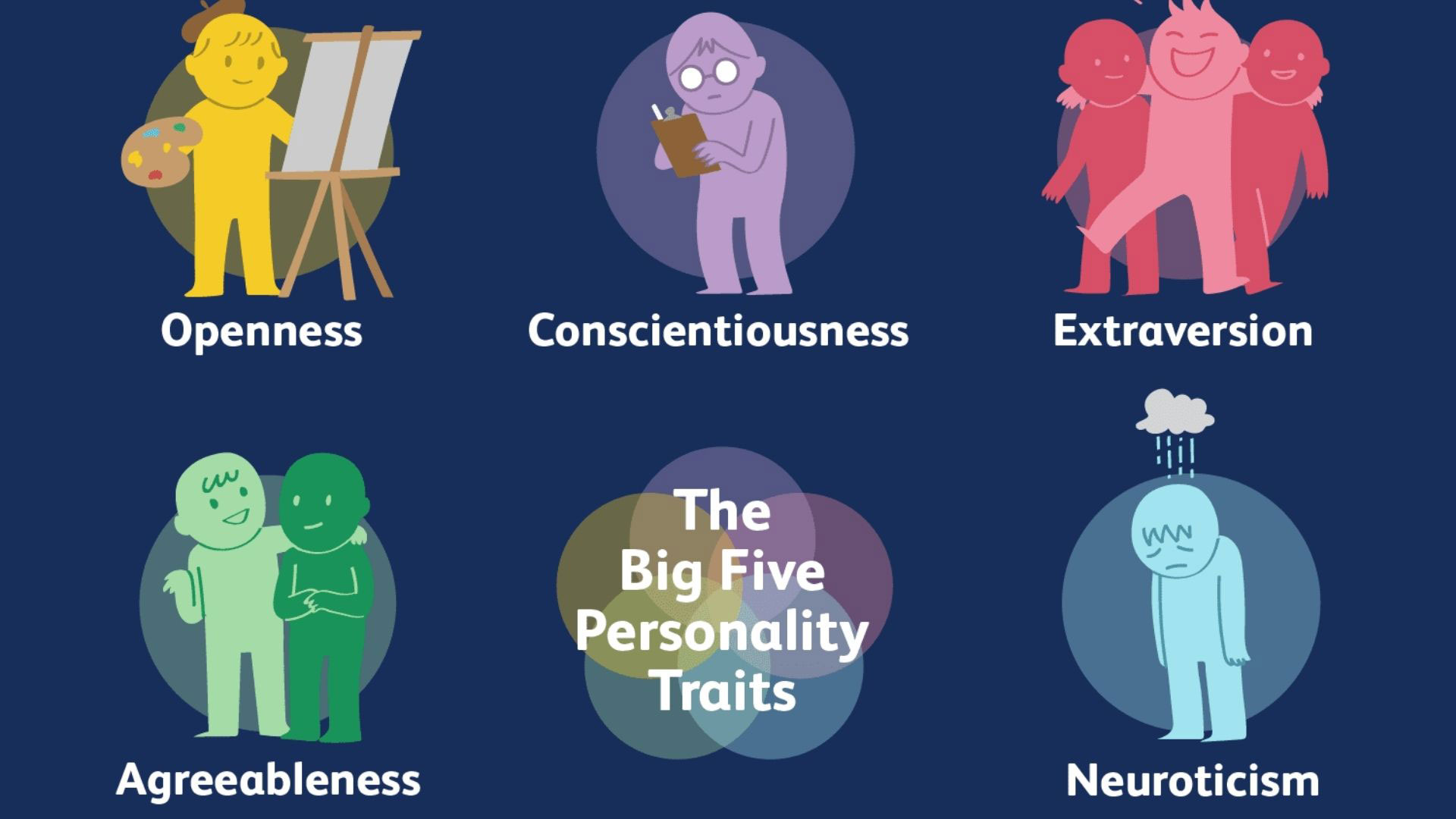Transcript
Disclaimer
I am using an automatic transcript service as it is not possible for me to do it on my own and I cannot afford human transcription at the moment. The service claims to have about 95% accuracy, which means there will still be some mistakes, so my apologies for having a less than perfect transcript, but I hope I can afford human transcription soon and I will solve this problem. However, the service is pretty good, and the transcript is almost perfect.
Transcript
Welcome to English plus podcast. Learn English, expand your knowledge and enjoy through our vocabulary. Builder, novel grammar, literature, psychology, essential guides and poetry episodes, support English plus podcasts by becoming a patron of the show on Patrion. Use the link in the description to support our podcast and to help our free e-learning journey.
[00:00:25] Continue. Welcome to a new episode from English plus podcast. And today is all about the key personality traits. Or the big five as many psychologists called them not to understand people’s personalities. It makes sense to start with the most important characteristics, the one that best help us to understand their behavior and that relate most strongly to important outcomes in their lives.
[00:00:53] This episode, we will focus on the five most important personality traits before turning to other characteristics in later episodes. As you will learn in this episode, extroversion and neuroticism are the most important, most informative traits in the human personality. Human personality is characterized by five basic personality traits known as the big five, many other traits exist, but these five have become recognized as the most important traits for understanding people’s personalities and behavior.
[00:01:30] As psychologists use it. The term personality trait is an internal, psychological characteristic that involves the tendency to respond in a particular way. Think about your behavior. Do you tend to be outgoing or more reserved in social situations? You probably aren’t either one all the time. Sometimes you are more outgoing and sometimes you’re more reserved.
[00:01:55] But if we followed you around and watched you in many different situations, we’d probably find that you show a tendency to lean one way or the other. The fact that you show a particular tendency in how you respond across situations suggests that you possess some psychological characteristic or perhaps a set of characteristics that predisposes you to react in one way or another.
[00:02:21] So we would say that you have a trait that predisposes you to then to be outgoing or reserved by definition. The concept of a trait implies that a person will show a certain degree of consistency in his or her thoughts, feelings, or behaviors across different situations. If you have a particular trait, we should be able to see a tendency for you to respond in a particular way across different situations.
[00:02:49] Of course, even when people have a trait, they don’t act the same way all the time, different situations call for different kinds of behaviors and people who act exactly the same way all the time. Don’t adapt to the demands of specific situations. No matter how outgoing you usually are. You must sometimes be reserved and no matter how reserved you usually are, situations sometimes require you to be sociable.
[00:03:17] The concept of trait also implies a certain degree of consistency over time in how people tend to respond. People’s personality traits can and do change over time, at least within limits. But over the short term, we see stability in their traits. If you tend to be outgoing this month, we aren’t likely to find that you have become consistently reserved a few months from now.
[00:03:42] It can happen. For example, if people experienced a traumatic event, but under normal circumstances, personality shows a good deal of stability over time. It helps to think of any given trait as a dimension or continuum that ranges from low to high and people are spread out along that continuum from those who are very low on the trade to those who are very high on the trade.
[00:04:08] People’s scores on most traits are normally distributed. In other words, if we look at people’s scores, we usually find that they show a classic bell shape or normal distribution in which most people score toward the middle with fewer and fewer people having more extreme scores as we move away from the middle in contrast to a personality trait, which can be visualized as a continuum.
[00:04:35] When we talk about a personality type. We are categorizing people into a small number of discrete categories or groups, sometimes only two groups. So instead of giving you a score on a continuous measure of a trait, we could simply classify you as being low or high in that trait. For example, we could classify you as a dominant or submissive person.
[00:05:00] As depressed or not depressed, or as an extrovert versus an introvert. In each case, we have classified you as a type of person, a dominant person, or an introvert. For example, by putting you in a category, personality researches, almost never talk about types because true personality types almost never exist.
[00:05:22] There are not many psychological characteristics in which people naturally or cleanly fall into one category or another. Instead, people vary from one another across all levels of a trade continuum. So let’s start with the first of the big five extroversion. How from the beginning of the scientific study of personality, everyone has agreed that the most important trait is extroversion.
[00:05:50] The trait of extroversion underlies more of people’s behavior and more of the differences that we see among people than any other trait, a psychological scientists may say that extroversion accounts for more variability in human behavior than any other trait, we can understand more about why people do what they do.
[00:06:11] If we know how extroverted they are, then by knowing about any other characteristic. When we talk about the trait of extroversion, we’re talking about a dimension that runs from being very low in extroversion at one end to being very high in extroversion at the other in everyday language, we often use the label introvert to describe people who are low in extroversion, but personality researchers generally talk about low versus high extroversion brother about introverts and extroverts.
[00:06:45] Partly that’s to avoid thinking of extroversion and introversion as if they’re personality types. Most personality, characteristics are continuous traits rather than categorical types. And that’s true of extroversion. In addition, we usually don’t contrast introverts with extroverts to avoid the suggestion that introversion is somehow the opposite of extroversion.
[00:07:11] Which it isn’t introvert simply fall in the lower tail of the normal distribution of extroversion scores. For example, introverts may like social interactions, less than extroverts do, but they don’t necessarily dislike interacting with other people at all. And introverts may be less assertive than extroverts are, but they aren’t necessarily nonassertive or submissive.
[00:07:35] Extroversion has a number of interrelated features. But its central characteristic is sociability. The higher the people score in extroversion. The more they enjoy interacting with other people compared to people who are low in extroversion. People who are high in extroversion are more gregarious. Enjoy social gatherings, more including large parties and seek out opportunities to interact with other people.
[00:08:03] More often when they’re in social situations, people who are high in extroversion are more talkative than people who are low in extroversion are. People who are high in extroversion are so highly motivated to interact with other people that when they’re alone for a long time, they sometimes go on a search just for somebody to talk to.
[00:08:27] Although sociability is the key feature of extroversion. People who are low versus high in extroversion also differ in other ways. For example, people who are high in extroversion tend to be more assertive and dominant than people who are lower and extroversion. They’re also more energetic and active and they like to stay busier than less extroverted people do.
[00:08:51] High extroverts also tend to be somewhat more upbeat and cheerful than people who are low in extroversion, but researchers don’t completely understand why extroverts tend to experience more positive emotions. One possibility is that physiologically high extroverts are more sensitive to rewards than people who are lower in extroversion.
[00:09:15] It seems that extroverts are more oriented toward having rewarding experiences and have a lower threshold for experiencing pleasure because they are more focused on rewards. People high in extroversion may tend to behave in ways that promote their own happiness more than low extroverts. Do. Another possible explanation is that given how much of life requires interacting with other people, those who really enjoy interacting with others will be happier in the course of everyday life than people who don’t enjoy interacting as much.
[00:09:51] So that was about extroversion. What about neuroticism? The second most important trait of the big five. It is usually called neuroticism, but because this word has such negative connotations, many researchers now call it emotional stability. The central feature of neuroticism or emotional stability is the degree to which people experience negative emotions.
[00:10:15] People who are higher in neuroticism tend to experience negative emotions more frequently than people who are low in neuroticism. And their negative emotions tend to be more intense and lasts longer. Some people simply experience unpleasant emotions, such as anxiety, sadness, anger, guilt, and regret more than other people do.
[00:10:39] In fact, some researchers call this straight negative emotionality. Although the defining feature of neuroticism involves negative emotionality. People who are high in neuroticism also display a general sense of insecurity and vulnerability. People who are high in neuroticism are more afraid of things that don’t bother other people very much.
[00:11:02] And they tend to worry more about bad things that might happen in the future. As they walk through life, they focus on the possible risks ahead risks involving their physical safety possible failures, public embarrassments, rejections, and so on. So they try to avoid situations that look risky or threatening people who are high in neuroticism also tend to overreact to ordinary kinds of hassles and frustrations.
[00:11:31] They get bent out of shape more easily than people low in neuroticism. They’re also less satisfied with their lives. This makes sense. If you tend to experience negative emotions frequently, everything seems less satisfying at the other end of the continuum. People who are very low in neuroticism, walk through life with a certain amount of equanimity and tend to be more satisfied with life.
[00:11:56] Not surprisingly, then people who score higher in neuroticism need more emotional support from other people. So they often tend to be somewhat needy and dependent. Hi, neuroticism is not only distressing for people, but it’s also associated with a number of negative outcomes. For example, neuroticism predicts more conflict and lower satisfaction in people’s marriages and other close relationships.
[00:12:23] The more people experience negative emotions, the more volatile their relationships tend to be. And the romantic partners of people who are high in neuroticism are less satisfied with their relationships. It’s more difficult to live with a partner who’s high in negative emotionality people high in neuroticism, also experience a greater number of health problems.
[00:12:46] And they’re particularly likely to get heart disease. Not only does a high level of stress create certain medical problems directly, but negative emotions can compromise the immune system in a way that makes it more difficult for the body to deal with whatever problem the person has. The connection is so strong that some psychologists have called neuroticism a major public health problem.
[00:13:10] Neuroticism has a strong genetic component. Some people are born with brains that respond more strongly to negative events. So they react more easily to threats of various kinds. But children can also learn to be neurotic. To some extent when parents are anxious or angry or upset a lot, their children learn to view high emotionality as normal.
[00:13:34] And they don’t observe their parents using effective coping strategies on top of that parents who openly express their own fears and concerns and who are over-protective can lead their children to perceive the world as a dangerous and unhappy place and worse parents who are neglectful, rejecting or abusive can cause their children to be chronically, fearful and vulnerable.
[00:13:59] Now for many years, the two traits of extroversion and neuroticism received bulk of attention from personality researchers until consensus emerged that there are in fact five major traits. And the other three traits are agreeableness, conscientiousness and openness, along with a six, three that has started getting attention, which we will talk about at the end of this episode.
[00:14:25] But now let’s talk about agreeableness. Once we move beyond the traits of extroversion and neuroticism. The third most important trait is agreeableness, which involves the degree to which people generally have a positive or negative orientation toward other people at the low end of the agreeableness dimension are people who simply aren’t very nice.
[00:14:48] They are often unpleasant even to the point of being antagonistic and hostile at times. And they tend to be inconsiderate and critical. Even Carlos at the high end of the agreeableness continuum are people who tend to be pleasant, kind, sympathetic and helpful. Like most streets, agreeableness is normally distributed.
[00:15:09] So most people fall in the middle with a mixture of positive and negative interpersonal characteristics. We can be very nice at times, but we can also be somewhat disagreeable. Agreeable people tend to have a more positive and optimistic view of human nature. They tend to believe that most people are basically honest and decent, so they trust other people more.
[00:15:32] People low in agreeableness have less positive views of other people. So they’re less trusting when they experienced conflicts with other people, highly agreeable people try to resolve the conflict in ways that are acceptable to everyone involved. So agreeable people value, negotiation more highly, and they are averse to using Bower or force.
[00:15:54] To get other people to do what they want along the same lines. Agreeable people are generally more cooperative and less competitive in their dealings with other people. Agreeable people are more helpful than less agreeable people are. Whether we are talking about helping family members, friends, or complete strangers, highly agreeable people are even more likely to donate their money and time when other people are in need.
[00:16:21] On the other hand, people low in agreeableness tend to be more prejudiced. They’re not only more prejudiced toward traditional targets of prejudice, such as certain races, ethnic groups and homosexuals, but also toward members of other stigmatized groups, such as people who are overweight. Two characteristics seem to dye all of this together.
[00:16:44] First, agreeable people place a higher value on their relationships with other people they’re more motivated to have pleasant, close relationships. So there are more, more willing to do things that maintain those relationships. For example, they make a greater effort to tolerate frustrations caused by other people, rather than getting angry or lashing out.
[00:17:06] In addition research suggests that agreeable people are more empathetic. They’re more likely to see the world through other people’s eyes and they experience greater distress when other people are suffering. So more agreeable people are more likely to treat other people nicely and to be kind and altruistic.
[00:17:26] That doesn’t mean that less agreeable people never have empathy for others, but they don’t automatically empathize with other people as easily as highly agreeable people do. Research shows that people who are higher in agreeableness are regarded as nice people are liked more and are more popular within their social groups.
[00:17:48] And they have more satisfying friendships and romantic relationships, including more successful marriages in part that’s because they simply get along better with other people. They also bring out better behavior in other people, their agreeable style elicits more pleasant and agreeable behavior from the people they interact with.
[00:18:08] Highly agreeable people create different social environments than less agreeable people do. And their agreeableness affects the behavior of other people. So that was about agreeableness. What about our fourth key trait of the big five that is conscientiousness? The fourth member of the big five is the trait of conscientiousness, which reflects the degree to which people are responsible and dependable.
[00:18:35] Conscientiousness comes down to whether people usually do what they should and whether they try to do it well. Responsibly doing what one should depends on a number of separate characteristics. And most of these underlying attributes are part of conscientiousness. For example, it’s difficult to do things conscientiously without being organized and orderly.
[00:18:59] And conscientious people are more organized and less conscientious. People are conscientiousness. Also involves industriousness and persistence. Conscientious people work harder because getting things done and doing them well takes effort and they are more likely to persist when tasks become difficult, boring, or unrewarding.
[00:19:21] A final component of conscientious is being able to make yourself do what needs to be done and to be able to resist the urge, to do something else instead, particularly if the alternative is more fun than what you’re supposed to do. So a key feature of conscientiousness is impulse control and a high level of self-discipline impulsive people who don’t control themselves.
[00:19:46] Well, have a pretty hard time being conscientious. Being consistently conscientious might not always be fun. But it does have payoffs. For example, conscientious people are healthier and live longer than less conscientious people. Research shows that conscientious people are less likely to smoke, use drugs, abuse, alcohol, and become obese.
[00:20:10] And they’re more likely to exercise, practice, safe, sex and drive safely. It’s also related to using smoke alarms in your house, seeing a doctor regularly and following doctor’s orders when you’re sick. Higher conscientiousness is also associated with greater success in school at work and in close relationships, all other things being equal, conscientious students get higher grades and conscientious employees make more money at work.
[00:20:39] Low conscientiousness is associated with absenteeism, stealing from your employer and lower productivity on the job. In close relationships, people are more satisfied with their relationship. The higher their partner is in conscientiousness. In fact, conscientious people are less likely to get divorced than less conscientious.
[00:21:00] People are conscientious. People hold up their end of the relationship better and are less likely to break the rules by being selfish or cheating. Or by being violent or doing other things that damage relationships, because they’re more organized, orderly, and dependable conscientious people give their partners fewer reasons to be dissatisfied and their self-control may also help conscientious people hold their tongue when things are better left unsaid.
[00:21:28] Part of the reason why some people behave more conscientiously than other people do is because they’re motivated to behave that way. They have a desire to be organized, to be dependable, to do things carefully and to follow rules. In fact, highly conscientious people are sometimes motivated to be organized, orderly and careful, even when it doesn’t matter.
[00:21:51] But in many arenas of life, it does matter. And conscientious people are motivated by both the realization that responsible behavior often produces benefits. And by the fear of negative consequences that often result when people are not conscientious. So they’re organized their lives, set goals and pursue those goals.
[00:22:12] Less conscientious. People are simply less motivated to behave in these conscientious ways. And that brings us to the last of the big five. And that is openness. The fifth and the final trait of the big five is openness, which is sometimes called openness to experience the term openness, as it applies to this trade should be interpreted as something like receptivity, as in the sense of being open to trying a new experience or being receptive to a new idea, the trait of openness involves the degree to which people are generally open or receptive to all kinds of things.
[00:22:50] We’re not talking about interpersonal openness, being open in how you interact with other people, but rather an intellectual and experiential, openness, or receptivity to new things. People who score high in openness are more intellectually curious and imaginative than people who score low, which reflects an openness to new ideas.
[00:23:12] Open people are less dogmatic and more intellectually humble. They hold their beliefs less strongly and they’re open to considering new ideas and thinking about the world in new ways. They also enjoy trying new things. They’re also more flexible in their behavior. They’re willing to try new ways of doing things, and they’re less concerned about doing things a certain way, just because we’ve always done them that way.
[00:23:39] As a result of being open to new ideas, experiences, and ways of doing things, people who are high in openness live somewhat less traditional and conventional lives. They don’t feel a strong need to conform to social expectations. People who are low in openness show, less of each of these tendencies, they are less inherently curious are more certain that their personal beliefs are correct.
[00:24:04] Usually don’t like to try new things just for the sake of having a new experience. They tend to be more conventional and tend to be more set in their ways. Because openness is normally distributed. Most people show a mixture of these characteristics. They like a certain amount of novelty, but not too much.
[00:24:22] We’ll try new things now, and then are dogmatic about some of their beliefs, but open about others and so on. But many people fall toward one extreme or the other. And your reaction to descriptions of these extremes should tell you which way you lean. Open people admire openness while less open people find high openness, a little troubling research shows that people tend to gravitate into friendships and romantic relationships with people who have roughly the same level of openness as they do this effect is not strongly compared to many other things that bring people together.
[00:25:00] But it is there. Openness seems to be beneficial in people’s relationships. Because openness involves a willingness to consider that one might be wrong and being open to other views. People who are more open tolerate differences of opinion, better than those who are less open. So open people have fewer conflicts with other people than less open people do.
[00:25:24] Studies have also shown that people who are high in openness, like those who are high in agreeableness are less likely to be prejudice than people low in openness. This is because they are more open to different cultures, belief, systems, ideas, and kinds of people. Open people tend to report that their relationships with other people are more satisfying.
[00:25:46] They tend to get along with people better, and other people tend to like them more. People who score higher in openness, tend to enjoy aesthetic experiences more than people who are lower in openness. They’re higher in what researchers call aesthetic sensitivity, people hire and openness, enjoy sensory experiences, such as art, music, and beautiful scenery, more than people low in openness do.
[00:26:12] And they report feeling more observed and emotionally moved by these kinds of experiences. They even report. They get chills or goosebumps more often when they see beautiful things or hear beautiful music. So these were the big five, and that will bring us to the last one. I know I said the big five traits and I mentioned five traits, but this trait, yes, it is number six, but it is gaining importance and attention from researchers.
[00:26:42] So many researchers are now including it with the big five to have the sixth key trait to human personality. And this trait is called honesty. Humility research has recently uncovered what is perhaps the sixth fundamental trait. And some researchers have started including it in their studies alongside measures of the big five.
[00:27:06] This trait is generally referred to as honesty, humility at the high end of this trait continuum are people who tend to be consistently honest, generous, fair, faithful, and humble at below end of this continuum are people who tend to be deceitful, manipulative, greedy, sly, and arrogant. This sixth grade involves differences in people’s tendency to be self-centered and selfish at the high end are people who, although they look out for their own interests, as we all do do so in a way that considers other people.
[00:27:43] So they’re honest, generous, and fair, and they keep their commitments. The humility part comes in because selfishness often involves thinking that you are better than other people and thus entitled to get what you want by whatever means necessary. It’s difficult to be consistently honest, generous, and fair.
[00:28:02] If you arrogantly think you’re better than everyone else. So people who score high on this dimension also tend to be humble at the low end of the sixth grade are exceptionally selfish and self-centered people, people who are often deceitful, manipulative, greedy, and slide to get what they want. In fact, very low scores, show signs of psychopathy.
[00:28:25] Which involves almost total indifference to the wellbeing of other people. The researchers who first described the sixth factor called it the HEXACO. H E X, a C O. They called it the HEXACO model. And this is a clever name since hex refers to number six, but it’s an acronym actually. And every letter stands for one of the six traits H stands for honesty, humility, E for emotionality, the neuroticism factor X for extroversion, a for agreeableness, C for conscientiousness and all for openness.
[00:29:02] So that brings us to the end of this episode. We talked about the big five and we added this number six because it’s gaining attention. And also because it is proving to be a key trait in human personality. Understanding the key traits of human personality will help you understand yourself better and will help you understand the people around you, or at least some of the people around you better.
[00:29:26] And that should lead to better relationships with people and better understanding of yourself. That will be all for now. This is your host, Danny. Thank you very much for listening. And I will see you next time.










0 Comments